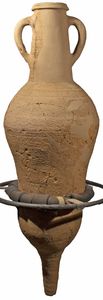Roman Amphorae: a digital resource
University of Southampton, 2005. (updated 2014) https://doi.org/10.5284/1028192. How to cite using this DOI
Data copyright © University of Southampton unless otherwise stated
This work is licensed under the ADS Terms of Use and Access.
Primary contact
Dr
David
Williams
Dept of Archaeology
University of Southampton
Avenue Campus
Highfield
Southampton
SO17 1BJ
England
Tel: 080 593032
Resource identifiers
- ADS Collection: 463
- DOI:https://doi.org/10.5284/1028192
- How to cite using this DOI
Melos

Courtesy of Superintendence for Archaeological Heritage of Piedmont and Museum of Egyptian Antiquities
Elena Quiri
Distinctive FeaturesLarge cylindrical amphora, classified by Raptopoulos (2005) as Melos 1a. Cipriano et al. (2005) denominated it as 'anfora ad impasto grezzo' (coarseware amphora) and subdivided it into three variants. The rim is wide and vertical with a deep engraved line in the middle which divides it into two parts. The lower part of variant 1 rim could be jutting and pointed compared to the higher one; variant 2 shows a hooked rim; variant 3 has a more moulded and internally concave rim. The curved handles are massive, oval in section, placed on a wide cylindrical neck. The shoulder is rounded and the body cylindrical with horizontal flutings, narrowing at the bottom. The spike has the shape of a truncate long cone. The neck is rarely stamped (variant 1 from Padua and variant 3 from Vercelli). Many variant 1 specimens from Padua have red coloured tituli picti, suggesting the content or onomastic indications (Pesavento Mattioli, 2005).There are no whole specimens of variants 2 and 3.See characteristics | ||
Date RangeBetween the end of the first century BC/first century AD up until at least the third century AD.Search: [1st century BC] [1st century AD] [2nd century AD] [3rd century AD] | ||
OriginMelos, where 'waster' specimens from the local kilns have been discovered (Raptopoulos, 2005). An origin on Melos is also confirmed by archaeometric analyses (Picon, 2001).Search: [The Aegean] | ||
DistributionThe distribution is rather patchy. Among the finds in the western Mediterranean are examples from Carthage and the lower Rhone Valley (Arles and Cavaillon: Borgard, 2005). To date, the majority of finds are in northern Italy: Padua, Oderzo, Iulia Concordia, Aquileia, Este, Cremona (Cipriano et al., 2005), Milan (Bruno & Bocchio, 1991), Torino, Novara, (Quiri & Spagnolo Garzoli, forthcoming), Chieri (variant 2: Riva, 1987), Vercelli (variant 3, Brecciaroli Taborelli, 1987).Search: [Italy] [Western Mediterranean] | ||
ContentsThe very coarse fabric does not seem suitable for foodstuffs. It has been suggested that the content was alum (Borgard, 2005; Pesavento Mattioli, 2005), because the fabric has many similarities with the amphorae used for the transport of alum from Lipari (Richborough 527) and Melos has considerable alum deposits (Hall & Photos-Jones, 2005).Search: [Alum] | ||
CommentsPrincipal contributor: Elena Quiri. |



 3D models
3D models


